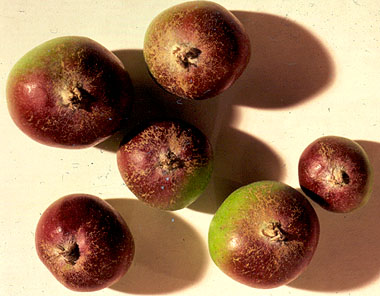Powdery Mildew (Apples) (Podosphaera leucotricha)
General Description
Symptoms: The fungus produces a white powdery growth on new terminal shoots, leaves (Fig. 1) and developing fruit.
.jpg)
Figure 1. Apple leaves infected by powdery mildew. (BCMA)
Later in the spring, as the fungus dries and is sloughed off, a network of russet appears on the infected surface of the fruit (Fig. 2).

Figure 2. Apples damaged by powdery mildew fungus. (BCMA)
Life Cycle
On apples the fungus overwinters in terminal buds and is most severe in a season following a series of mild winters. Severe winter temperatures can reduce mildew pressure by killing infected buds, which are more susceptible to winter injury than healthy buds. As infected buds open in the spring, powdery mildew spores (conidia) are released to initiate primary infections on blossoms, young leaves and fruit. Infections causing fruit russet can occur from about 3 weeks before bloom to 3 weeks after bloom. Additional conidia are produced on infected leaves and fruit which cause secondary infections. There are multiple generations per year, with trees susceptible as long as they are actively growing. Powdery mildew is favoured by moderate temperatures (10-15°) and high relative humidity.
Management
Cultural Control
1. Avoid overcrowding of trees and branches.
2. Prune out twigs with white fungus growth on the surface.
Chemical Control
Early spring applications of fungicide (beginning no later than tight cluster) are necessary to prevent secondary spread of powdery mildew in susceptible apple varieties. Neglecting control early in the year will result in poor control during the season.
Dormant Monitoring: The number of mildew sprays required on bearing trees prior to blossom can be predicted by estimating the percentage of one-year old shoots showing white fungus on the bark surface during the dormant season. If more than 15% of one-year-old shoots have mildew, two pre-bloom sprays are required. Spray once prior to bloom for levels between 5 and 15%. Pre-bloom sprays may not be required if the mildew level is below 5%.
Fruit - Fungicide application at the pink stage is a critical timing to prevent fruit infection and subsequent fruit russeting.
Foliage - A single pink spray will not protect the foliage of susceptible varieties such as Honeycrisp, McIntosh, Granny Smith, Gala, Jonagold and Ginger Gold. Two pre-bloom sprays are needed for good control of powdery mildew where disease levels are high. Apply fungicides at 10-day intervals or as labels direct, from tight cluster until terminal growth ceases, to keep foliage free of mildew and to reduce carry-over to the next season. Control of foliage powdery mildew is particularly important in nurseries and on young trees. On more resistant varieties such as Red and Golden Delicious, damage from moderate amounts of mildew on terminal growth is relatively minor and does not warrant an extensive spray program.
Fungicides Registered for Powdery Mildew on Apple:
- Aprovia (benzovindiflupyr)
- Aprovia Top (benzovindiflupyr + difenoconazole)
- Fontelis (penthiopyrad)
- Luna Tranquility (fluopyram +pyrimethanil)
- Nova (myclobutanil)
- Fullback (flutriafol),
- Flint (trifloxystrobin)
- Funginex (triforine) - apple nursery stock and non-bearing trees only
- Pristine (boscalid + pyraclostrobin),
- Sercadis (fluxapyroxad),
- Kumulus or Cosavet (sulphur),
- Senator (thiophanate-methyl)
- Sovran (kresoxim-methyl)
- lime sulphur
- Inspire Super (difenoconazole + cyprodinil) - suppression
- Serenade Opti (Bacillus subtilis) - suppression
- PureSpray Green Spray Oil 13E - suppression
- Diplomat (polyoxin D) - suppression
CAUTIONS
- Lime sulphur may cause fruit russet and disrupts integrated mite control. To minimize the risk of fruit damage, do not use past full bloom.
- Sovran may severely injure certain varieties of cherries. Do not allow drift onto cherries.
- Senator may harm predatory mites. If several sprays are applied, follow mite counts closely for indications of spray interference with predatory mite population.
Resistance management – Rotate between different fungicide product Group Numbers to help prevent the development of fungicide resistance. Use recommended rates for powdery mildew control. Reduced rates will result in poor control and an increased risk for resistance development. Refer to the table: Chemical Classification & Pesticide Resistance Management for information on fungicide resistance groups and the risk of resistance for different products.
There is apple scab resistance to Senator in most orchards of the central and north Okanagan. It is suspected that resistance to Nova is starting to develop in apple powdery mildew. Limit sprays of Nova and other group 3 fungicides to once or twice per season.
Updated July, 2018
